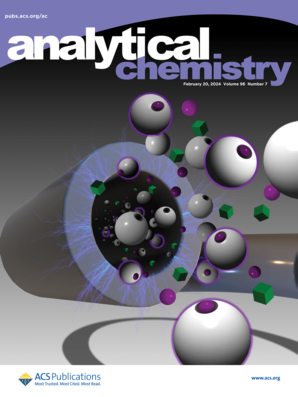Design of Multi-Cancer VOCs Profiling Platform via a Deep Learning-Assisted Sensing Library Screening Strategy
IF 6.7
1区 化学
Q1 CHEMISTRY, ANALYTICAL
引用次数: 0
Abstract
The efficiency of sensor arrays in parallel discrimination of multianalytes is fundamentally influenced by the quantity and performance of the sensor elements. The advent of combinational design has notably accelerated the generation of chemical libraries, offering numerous candidates for the development of robust sensor arrays. However, screening elements with superior cross-responsiveness remains challenging, impeding the development of high-performance sensor arrays. Herein, we propose a new deep learning-assisted, two-step screening strategy to identify the optimal combination of minimal sensor elements, using a designed volatile organic compounds (VOCs)-targeted sensor library. 400 sensing elements constructed by pairing 20 ionizable cationic elements and 20 anionic dyes in the sensor library were employed for various VOCs, generating plentiful color variation data. By employing a feedforward neural network─random forest-recursive feature elimination (FRR) algorithm, sensing elements were effectively screened, resulting in the rapidly producing 8-element and 10-element arrays for two VOC models, both achieving 100% discrimination accuracy. Furthermore, a smartphone-based point-of-care testing (POCT) platform achieved cancer discrimination in a simulated cancer VOC model, using image-based deep learning, demonstrating the rationality and practicality of deep learning in the assembly of sensor elements for parallel sensing platforms.

基于深度学习辅助传感库筛选策略的多肿瘤VOCs分析平台设计
传感器阵列在多分析物平行鉴别中的效率从根本上受到传感器元件数量和性能的影响。组合设计的出现显著地加速了化学文库的产生,为开发健壮的传感器阵列提供了许多候选材料。然而,筛选具有优异交叉响应性的元件仍然具有挑战性,阻碍了高性能传感器阵列的发展。在此,我们提出了一种新的深度学习辅助的两步筛选策略,使用设计的挥发性有机化合物(VOCs)靶向传感器库来确定最小传感器元素的最佳组合。将传感器库中的20种可电离阳离子元素和20种阴离子染料配对,构建400个传感元件,对各种VOCs进行检测,得到丰富的颜色变化数据。通过采用前馈神经网络─随机森林递归特征消除(FRR)算法,有效筛选感测元素,快速生成两种VOC模型的8元和10元阵列,均达到100%的识别精度。此外,基于智能手机的POCT (point-of-care testing)平台利用基于图像的深度学习,在模拟癌症VOC模型中实现了癌症识别,证明了深度学习在并行传感平台传感器元件组装中的合理性和实用性。
本文章由计算机程序翻译,如有差异,请以英文原文为准。
求助全文
约1分钟内获得全文
求助全文
来源期刊

Analytical Chemistry
化学-分析化学
CiteScore
12.10
自引率
12.20%
发文量
1949
审稿时长
1.4 months
期刊介绍:
Analytical Chemistry, a peer-reviewed research journal, focuses on disseminating new and original knowledge across all branches of analytical chemistry. Fundamental articles may explore general principles of chemical measurement science and need not directly address existing or potential analytical methodology. They can be entirely theoretical or report experimental results. Contributions may cover various phases of analytical operations, including sampling, bioanalysis, electrochemistry, mass spectrometry, microscale and nanoscale systems, environmental analysis, separations, spectroscopy, chemical reactions and selectivity, instrumentation, imaging, surface analysis, and data processing. Papers discussing known analytical methods should present a significant, original application of the method, a notable improvement, or results on an important analyte.
 求助内容:
求助内容: 应助结果提醒方式:
应助结果提醒方式:


